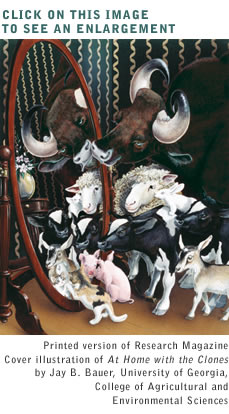


— J.B.P.

Eight and Counting
The 1997 announcement of Dolly, the cloned sheep, broke a scientific sound barrier. The news stunned the masses, rocked the scientific world and left just about everyone grappling with a new reality: The long-held “truth” that mammalian reproduction is strictly limited to eggs and sperm was no longer true.
Cloning could change the world in ways we cannot yet imagine, much like Orville and Wilbur Wright’s Kittyhawk flight set the stage for interplanetary travel.
UGA animal science professor Steve Stice is among the scientists on the forefront of cloning. Since joining the faculty in 1998, Stice and his research team have improved cloning efficiency of cattle five-fold, have cloned a calf from a slaughtered cow’s kidney cells and are now working to improve cloning efficiencies in hogs. His team also is doing research that could help lay the groundwork for developing a generic type of host egg that could be used to clone a variety of mammals, from livestock to endangered species.
Since Dolly’s birth, eight species of mammals have been cloned from a variety of adult cells and they are listed below.


Dolly, the sheep. Born July 5, 1996; announced in Feb. 1997. Ian Wilmut et al., Roslin Institute and PPL Therapeutics, Scotland. Cloned from mammary cells.
Cumulina, the mouse. Born Oct. 3, 1997; announced in 1998. Ryuzo Yanagimachi et al., University of Hawaii Medical School. Cloned from ovarian cumulus cells that nourish a fertilized egg.
George and Charlie, the Holstein calves* born Dec. 1997; announced in Jan. 1998. Steve Stice and James Robl, Advanced Cell Technology and University of Massachusetts. Cloned from embryonic skin cells (fibroblast cells).

Mira, the goat* born Oct. 1998; announced in April 1999. Patricia Diamond et al., Louisiana State University, Genzyme Transgenics Corporation (now known as GTC Biotherapeutics) and Tufts University. Cloned from embryo material collected from a 40-day-old goat embryo.
Millie, the pig (and her identical siblings Christa, Alexis, Carrel and Dotcom). Born March 5, 2000. PPL Therapeutics (Scotland) with partners in Blacksburg, Va. Cloned from pig fetal cells.
Noah, the gaur, an endangered wild ox. Born Jan. 8, 2001. Philip Damiani et al., Advanced Cell Technology. Cloned from a gaur skin cell transferred into a cow ovum and carried to term by a cow.

CC, the domestic cat. Born Dec. 22, 2001; announced in Feb 2002. Mark Westhusin and Taeyoung Shin, Texas A&M University. Cloned from cumulus cells.
# 6339C, a rabbit (was given a number instead of a name). Born March 4, 2002. Jean-Paul Renard, National Institute of Agronomical Research, and Marc Le Bozec at BioProtein Technologies (France). Cloned from cumulus cells.
* Denotes a transgenic clone, which means scientists insert a specific gene from a different organism into the genetic material of the animal to be cloned before creating an embryo.
— J.B.P.
For comments or for information please e-mail the editor: jbp@ovpr.uga.edu
To contact the webmaster please email: ovprweb@uga.edu
![]()